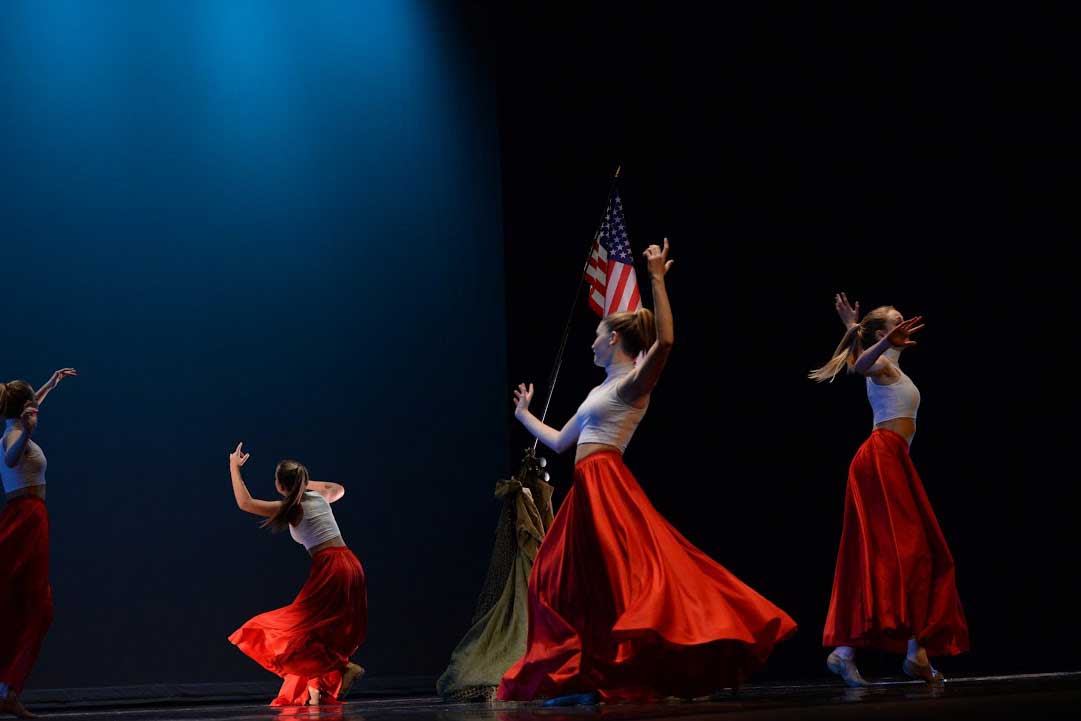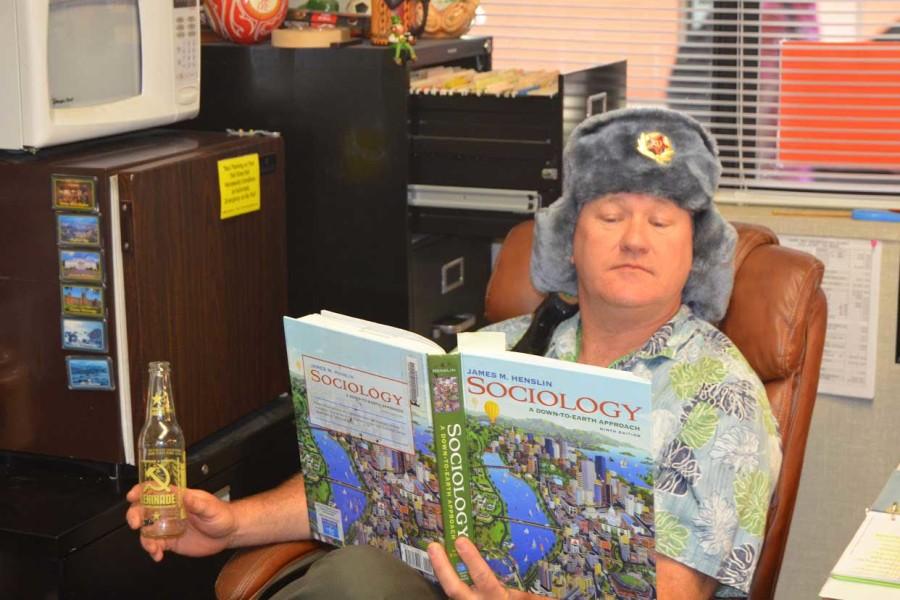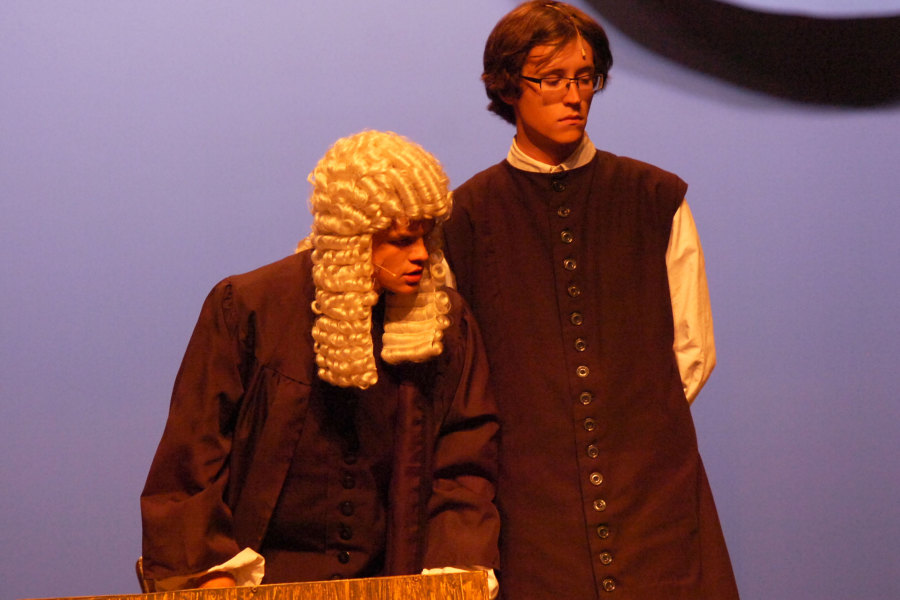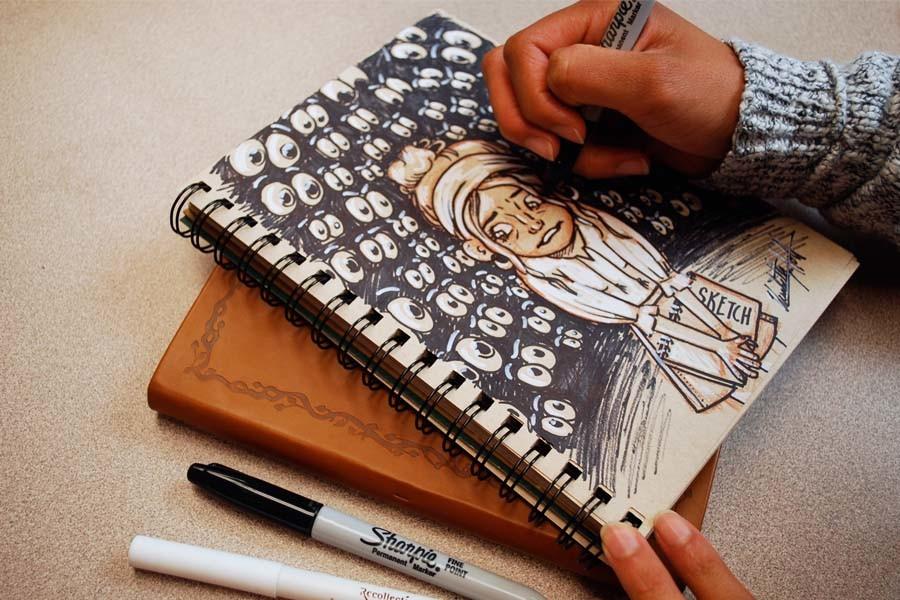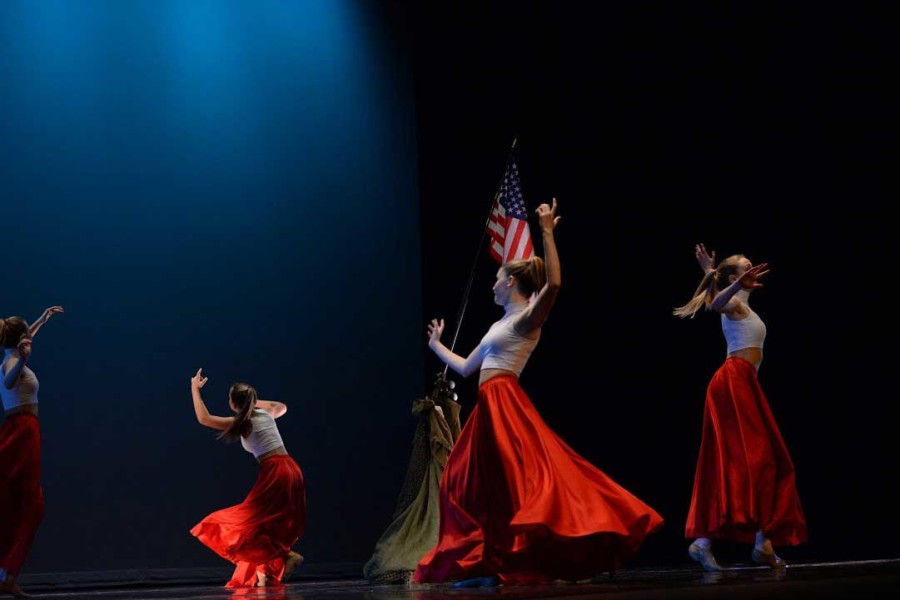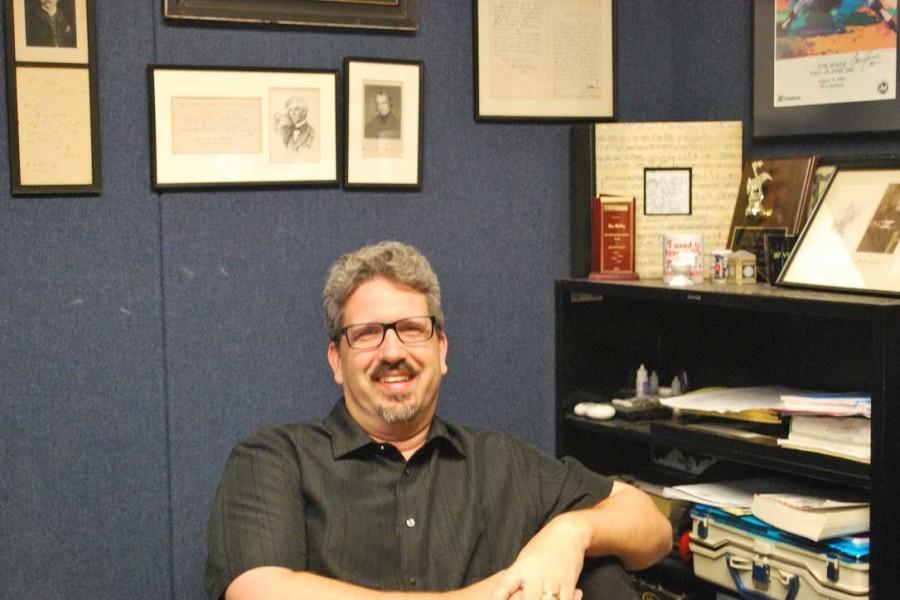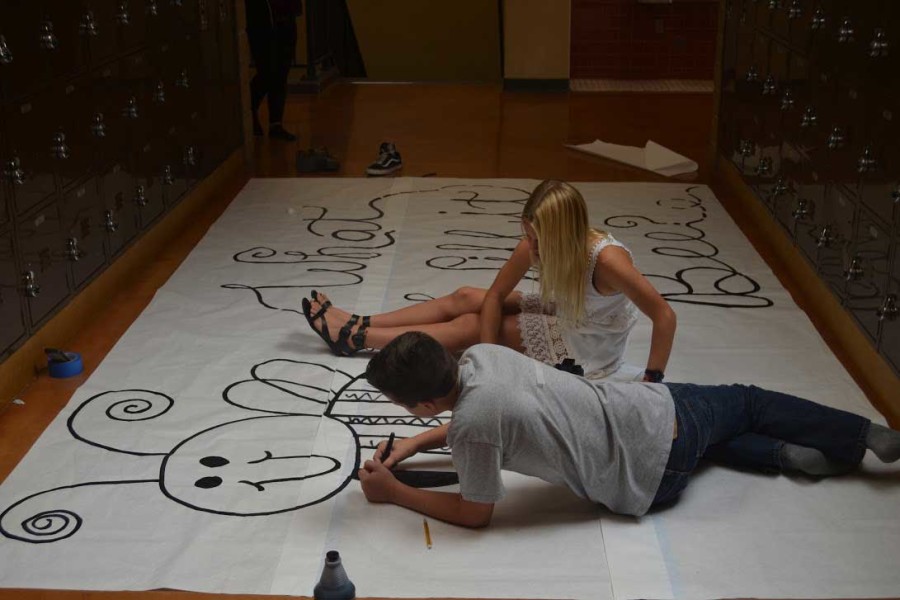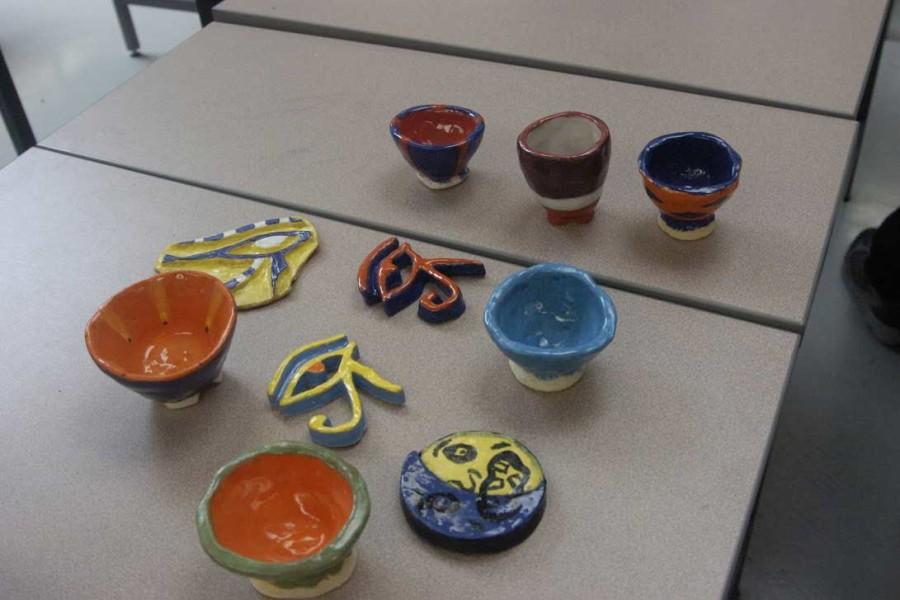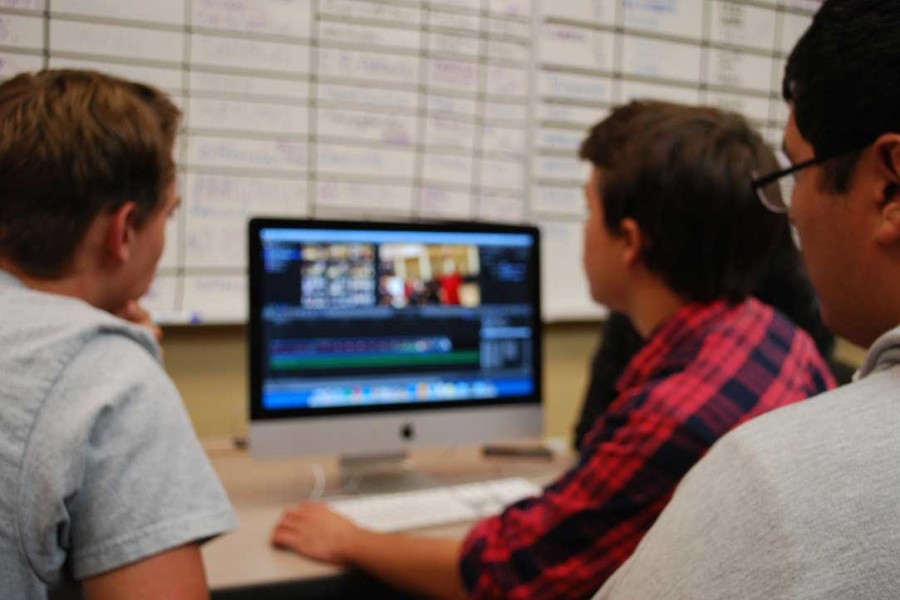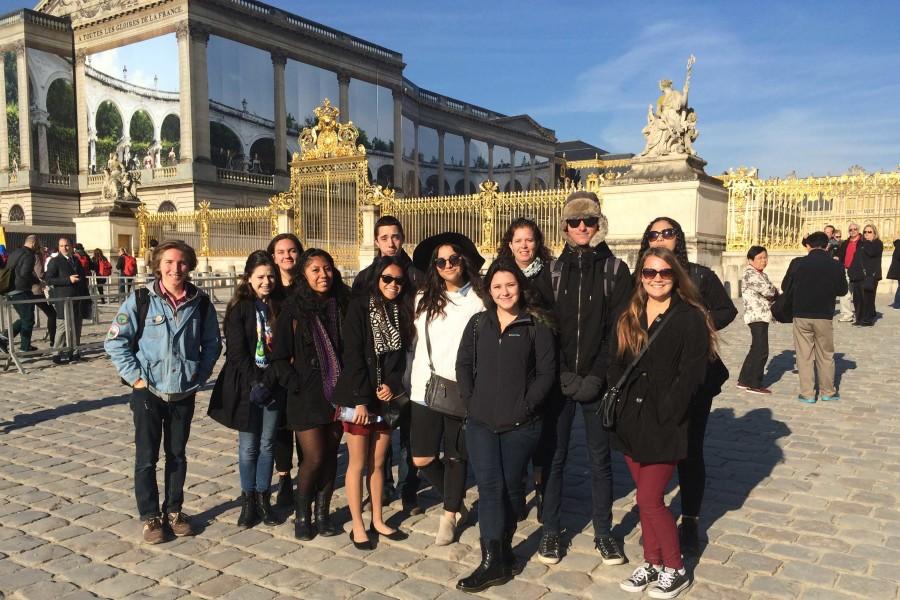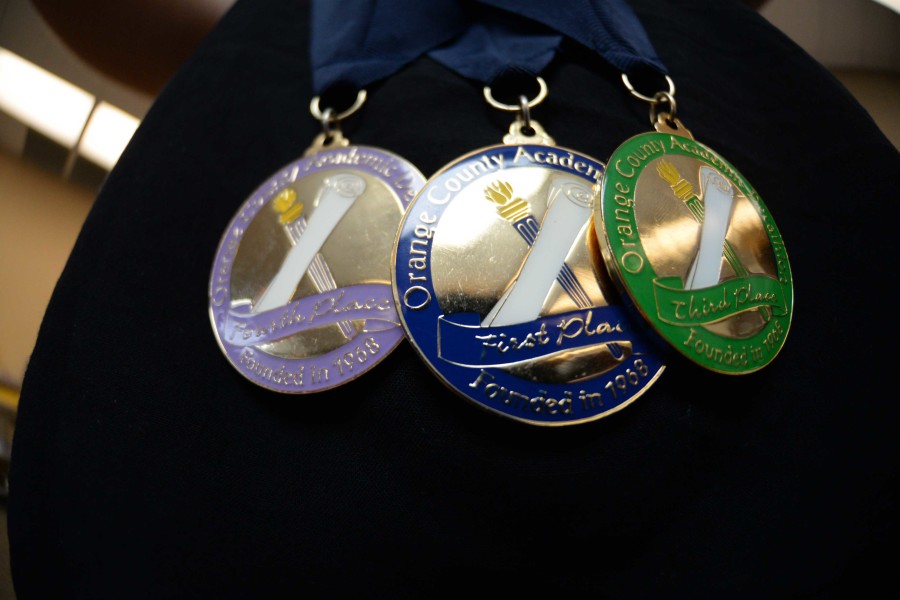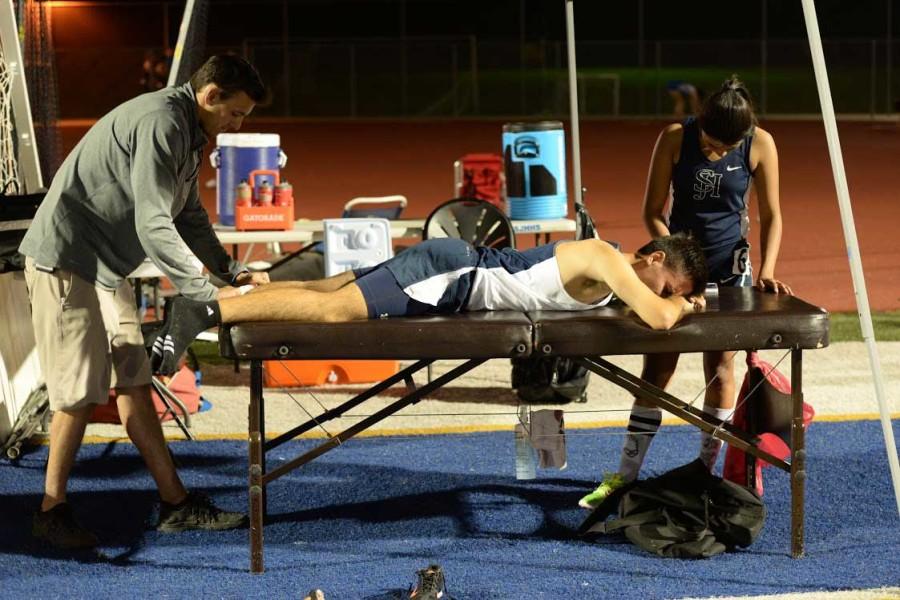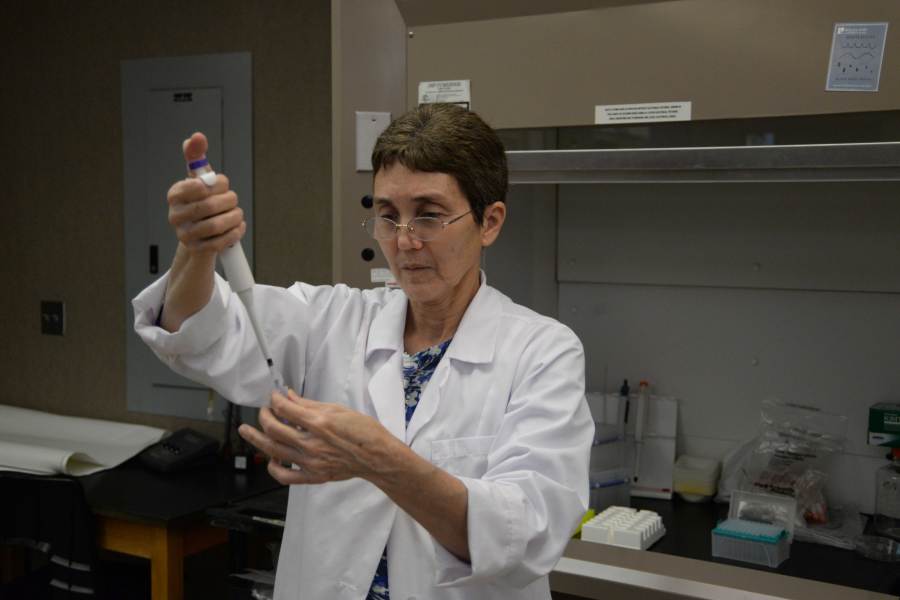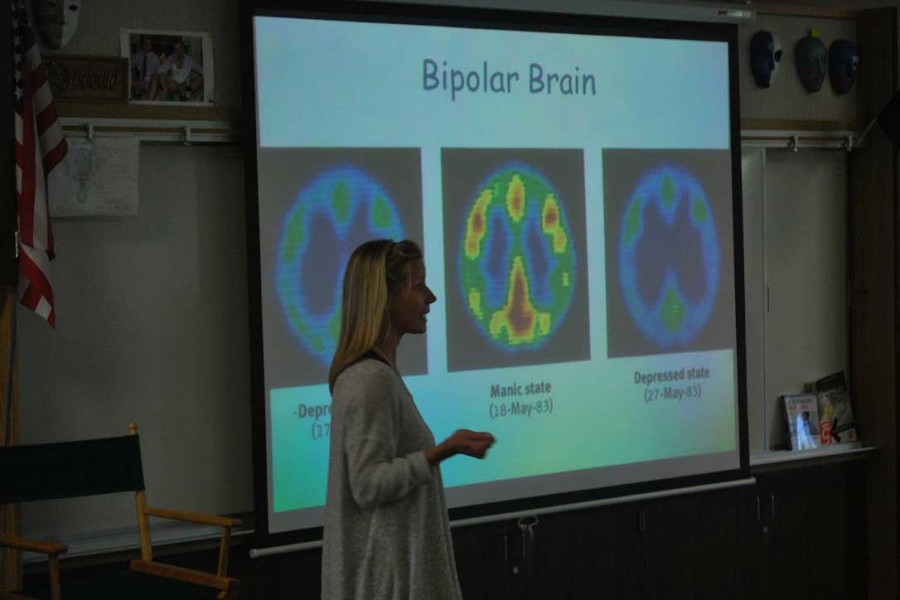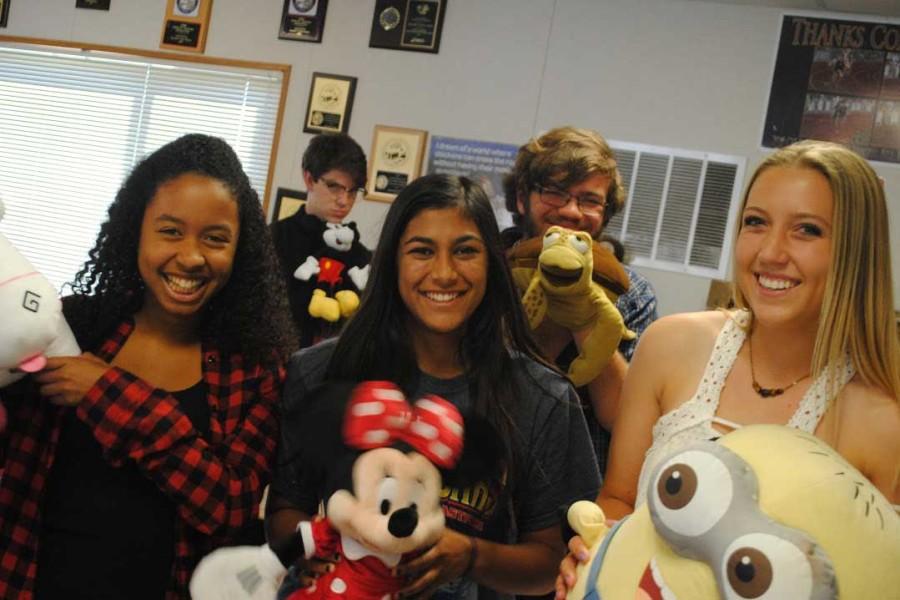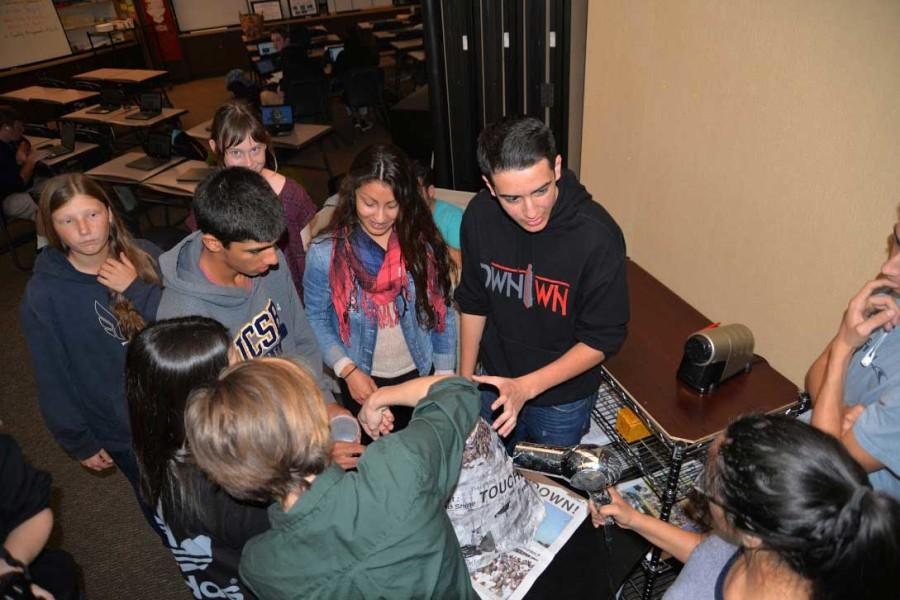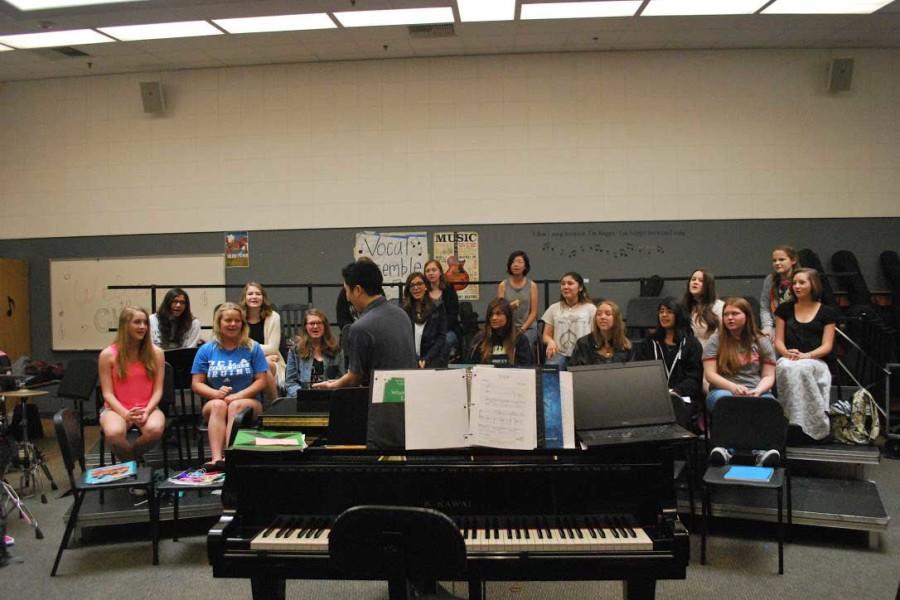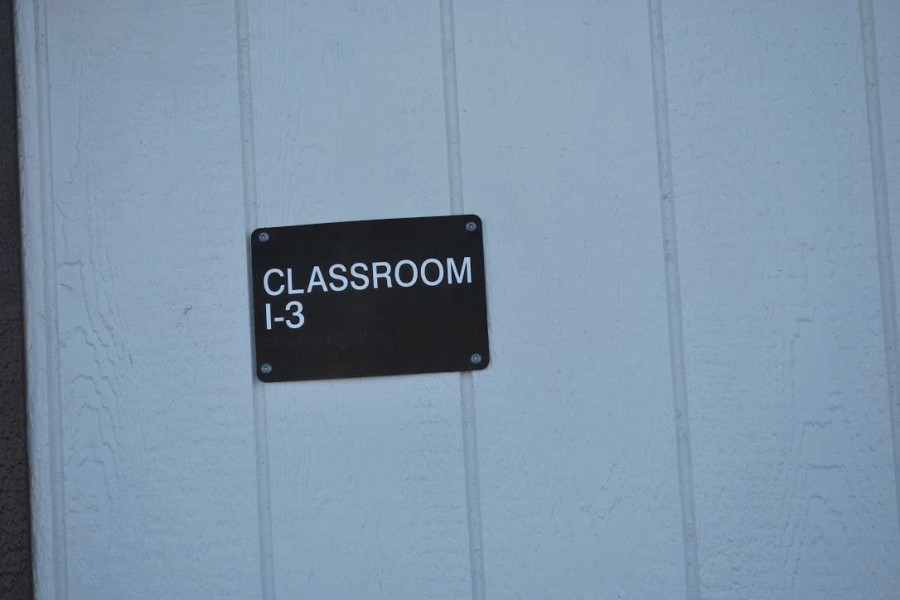Your donation will support the student journalists of San Juan Hills High School. Your contribution will allow us to cover our annual website hosting costs.
Electives
April 16, 2015
Multimedia design
The multimedia design class is taught by Jeremy Wooten. The class is about learning Adobe Design and Illustrator on the PC. Photoshop is when you take photos and you adjust them by changing backgrounds and effects of the picture. Illustrator is used for making logos and cartoons, the use for the application is endless.
“The class is about taking photos and enhancing them, making adjustments to them, and taking out backgrounds and add effects to make the picture look better and that is first semester, in second semester they use Illustrator to create logos for companies and web pages,” said Wooten.
This class counts for elective credits and it is a year long class.
“Colleges look at this class for kids who want variety and have the necessary skills,” said Wooten.
This class can open doors to different jobs that are needed in the world. Wooten is looking for students who want to learn Photoshop skills, but anybody who has the desire to learn can take this class.
“This class is great you get to design anything you want to and you get to make brand logos and cartoons in the second semester so it brightens the end of the school year,” said Chris Gardea (11).
School of Rock
Expressing yourself through your musical talents is one of the many aspects that Commercial Music has to offer.
Commercial Music allows you to go out of your comfort zone in a performing light. They hold in-class performances after the assignments are completed, which expands your performing ability.
Mr. Ushino, even though new to SJHHS, has proven himself to his students with his helpful personality.
“He is very laid back and he’s the type of guy who is always willing to help you achieve what you want to achieve,” said Ben Hill (12), a student in commercial music.
Although Commercial Music is new to SJHHS it is definitely a course we have missed out on until now. This course goes in depth on how to work with other members and experience what it would be like to work in the music writing and recording industry.
“You learn a lot of stuff like how to write songs, how to work as a team, and it helps you become more confident in performing in front of people,” said Gabrielle Land (11), another student in commercial music.
Students enrolled in Commercial Music will earn elective credits towards graduating. Students should join this course if they are willing to express themselves through their talents in the arts and have a love for music.
It’s All About Us, Who We Are: Sociology
A LITTLE BIT OF LEMONADE HELPS FOR A LONG DAY OF SOCIOLOGY: A chilly Mr. Spiers warms up by putting on his favorite hat and reading his little slice of heaven: Sociology. In Sociology, you’ll learn about other ethnicity, gender, sex, etc. while also learning about yourself. Photo by Carlos Pita
“It’s all about us. Who we are. Society. Sociology.”
– Sociology Teacher, Mr. Spiers
“Engaging, stimulating, and good note-taking,” are three words that describe Mr. Spiers’ sociology class. Sociology is the study of society, social institutions, and social relationships. “We study social interaction and how people act, and norms with one another,” said Justin Guglielmana (11).The subject matter that is covered in this class has a wide scope, ranging from sex and gender to race and ethnicity. Although sociology is a single semester, it opens the door to go even further and major in it in college.
In Mr. Spiers’ class, students are taught by lectures, but also by each other, through a very open and welcoming environment. “We’re all interacting with each other and we all learn from each other,” said Dazmin Arnaud (11).
The different characteristics explored in this course include religion, social control and deviance, sex and gender, and the general culture of a certain people. “We learn how people interact with other people and how cultures are,” said Brayden Hagerty (12). Gender roles, unlike sex, can change. Gender isn’t, however, as simple as just choosing a role to play but is also influenced by parents, peers, culture and society; which has changed dramatically over the recent couple of years.
The difference between race and ethnicity will also be a topic of discussion in this course. An individual is often pegged physical characteristics or racial features (such as color of skin) rather than their personality. Ethnicity, on the other hand, is classified more as the social and cultural portion of a certain population, not just a single individual.
COURSE DESCRIPTION:
This course provides the student with a scientific understanding of human groups. Group interaction, conformity versus individualism, social change, social planning, minority groups, crime and poverty, suicide, and other current topics are covered in the context of human relationships and interactions.
WHAT THIS COURSE GETS YOU: Sociology is a one semester class that gives you 5 elective credits and fulfills the A-G requirements.
WHAT TEACHERS ARE LOOKING FOR IN STUDENTS: Students who are willing to learn about each others and, more importantly, themselves.
AVID Leads Students To Success
Advancement Via Individual Determination (AVID) is a program that is nationally recognized and primarily designed for students that are motivated to be college bound. The main focus for the program is for students to attend a four year university after their high school career.
AVID has requirements that apply to each student who chooses to be a part of the AVID family. Each student must participate in some kind of extracurricular activity and fulfil at least 30 hours of community service. All AVID students must maintain at least a 3.0 GPA and commit to college entrance exams as well as college prep courses until prepared for rigorous AP course options.
To apply, students must write an essay about why they belong in AVID and also must attend the interview on May 20, 2015 at 5:30 p.m. in Mrs. Villalba room D09.
In order to successfully reach the goals set at hand for the class and each individual, they focus on different skills such as time management, organization, and different study habits like cornell notes.
“If you want to go to Stanford and be a doctor and that is what you want to do, well you have to think… I have to get really good grades while enrolled in rigorous classes. Well, where can I get the help and support? Oh well, that’s when AVID comes into play,” said Mrs. Gideon.
Seinor of AVID 2015 Giovnny Menchaca explains, “It’s just a good time you get to get super close to people because you are with them for four years, the teachers are insanely funny. The field trips are fun to hangout with friends and learn about different universities that you may have never known.”
The program is designed for those that do not not struggle with attendance or behavior. Most AVID students are likely to receive higher grades, complete college entrance requirements, and even be accepted to college and complete it.
“I have been in AVID for four years and it has kept me motivated and kept my head in the game, you should join AVID if you are serious about attending college and know you need help and want that family environment to help push yourself to get there,” said Janette De La Cruz(11).
Español Hablada Aquí
SJHHS offers 7 levels of Spanish classes, from Spanish I through Spanish for Spanish Speakers II. All 7 levels of Spanish fulfil the CUSD foreign language requirement of 10 credits by graduation.
Introductory levels focus on building the basic skills for success in the language, such as vocabulary and basic grammar.
“I really enjoy being in Spanish II because I get an extended knowledge of what I learned last year in Spanish I. It’s difficult, but cool to learn about the language and the cultures of Spanish speaking countries,” said Sid Piravi (9).
As students progress through the courses and eventually reach the AP levels IV and V or Spanish for Spanish Speakers, the classroom becomes a “Spanish only” zone and the focus shifts away from grammar and instead stresses cultural awareness, literary analysis, communication skills, and eloquence in speaking.
“AP Spanish V has been a fantastic experience in regards to my overall understanding and appreciation of hispanic culture. The class has not only allowed me to exercise the language in a practical, real world setting, but it also provides the opportunity to apply my speaking and writing skills to the analysis of the most influential works in Spanish literature,” said Diego Bennett (12).
Although the district only requires students to complete 10 credits of a foreign language in order to graduate, there are incentives for continuing a foreign language beyond the requirement. The District’s Seal of Biliteracy is awarded to any student who either passes a foreign language AP test with a score of 3 or higher, passes the SAT II test for the language with a score of 600 or higher, or completes four years of the language with a 3.0 average.
“I get to work a group of diverse students, and I get to see them from the beginning of their Spanish careers at SJHHS. I see students progress, mature, and I just love watching them become bilingual, bicultural, and biliterate students,” said teacher, Fernanda Villalba.
Any student who is interested in learning about the culture of Spanish speaking countries or has a desire to improve their skills in another language should consider enrolling in Spanish at SJHHS.
Performing in the Fine Arts
Judge Danforth (Nicholas Welter) assures Reverend Hale that his court is not corrupted and no man need fear it while Reverend Parris (Graham Morris) looks on with disapproval.
Drama 1, Musical Comedy, Stagecraft, Theatrical Production, and Actors Repertoire are all classes that fall under the theatrical umbrella. They are all taught by Mrs. Beilstein who is a master of multitasking.. From lighting to sound to the setting to actual acting and everything else between, each class builds the theater setting. Anyone with a love for the arts can and should join theater classes. Even the shyest aficionado or beginner may join to lend help. Or for the more gregarious, getting into Drama 1 may be a fun and exciting way to contribute.
“Beginning Drama is a great way to not only get involved with preliminary acting craft- if it is totally unfamiliar to you, but additionally it helps with general confidence and presentation skills. So, if you do not want to be an actor, it is still fun and real life applicable!”says Drama teacher Mrs. Beilstein.
In Drama 1A and 1B, students learn the skills required to stand and speak on a stage. Basic acting skills, theory, and technique are taught. In class they play theater games and review monologues. In musical comedy they learn to sing, dance and act, all at the same time attaining a high degree of skill and coordination. This “Triple Threat” allows them to perform any acting style.
For a more behind the scenes education one may enter Stagecraft and Theatrical Production. In this class students learn and work on costume design, makeup, props, and the building of the set. Before a production students will either build, paint, or general design and layout. Post-production students take down and clean up the set. Theatrical Production builds on these skills and is the more advanced of the two.
“Most kids take stagecraft their freshman and sophomore year and their Junior or senior year they take Theatrical Production.” says student Sarah Stickler(12).
For the most dedicated Theatre students, Actors Repertoire provides an outlet for their creativity. In Actors Repertoire, students work with an acting company at San Juan Hills Hills to Produce, Direct, and Act in a play every six weeks.
“It is considered the highest level of commitment and study to theatrical arts at the school.” says student Pierce Livingston (12).
The Theater classes are a great program to join for anyone who has any interest in the fine arts.
THINKING WITH YOUR PENCIL: A drawing and painting student works on shading a cartoon style portrait. The drawing and painting course teaches students to translate their emotions into the form of a drawing through basic drawing techniques, as exemplified by this student. Photo by Ellie Holt
Thinking With Your Pencil
“Anyone can draw,” art and ceramics instructor Jan Colt says, “ ”
The SJHHS drawing/painting and ceramics courses inspire students to create using techniques developed by artists throughout history dating from the first contour cave drawings to the modern non-objective art of the 21st century.
The 21st century marks the revolutionary advancement in computer technology, meaning the increase in importance and need for workers with skills in the visual arts.
Companies, careers, and jobs now search for creative people who know how to learn and communicate using constantly changing technology and are trained to think, draw and design using visual arts based skills. The creative problem solving and visual observation techniques desired by employers form the foundation for the art curriculum provided at SJHHS.
“I believe that taking this art class has furthered my skills in preparation for being a fashion designer when we learned eight figure heads (figure drawing) and also creating the illusion of 3D in drawings.” Maggie Barnes (11)
In addition to equipping students with skills to enter the workforce, the drawing/painting and ceramics courses encourage and inspire students to delve deeper into their minds and express their individual creativity, discovering talents and abilities that may not know they possess themselves.
“This class provides us with an environment where we are free to express our thoughts emotions and imaginations with all the tools necessary.” Alex Pagan (12)
For All Dancers
This dance is inspired by the heroes depicted in the statue, Iwo Jima by Felix de Weldon. Each of the performances in the show (titled Masterpiece) was inspired by art pieces from all different cultures and time periods. Photo by Maggie Barnes and Ellie Holt
The SJHHS dance program offers classes for students from all levels of dance, from advanced to beginning. Whether you have many years of experience or no experience at all, there is a class that is catered to your capabilities.
To be admitted into beginner dance, there is no certain requirement of experience. Students who join must be passionate about dance and willing to put their best effort into learning the basic foundations.
Beginning Intermediate and Intermediate Production are for those who have slightly more experience. To be admitted into Beginning Intermediate, students must have a minimum of one to two years of background experience. For Intermediate Production students must have two or three years of background experience.
Madi Bauman (10) said, “The people that are taking it are really great and you don’t have to be the best dancer because there are lower levels and you can build upon and work up throughout the years so its a overall good experience.”
Those who wish to be in Advanced Dance Production must have at least four to six years of training. These requirements are necessary in order for students to be able to perform to the set standards in each level of dance.
Tryouts for the higher level classes are held on June 5 in the small gym where students have the opportunity to show off their skills, and have the opportunity to be placed in a higher level of the program.
For students who may interested in pursuing a career involving dance there is also a year long ROP dance class that is offered as well. This ROP class is taught at SJHHS, and is during third period.
Throughout the school year students are able to perform for their peers as well as family and friends during the various showcases hosted at SJHHS. These performances include shows such as Fusion, the Student Choreography Ball, and the Choreographers’ Ball where students perform a dance taught by professional choreographers.
“What I love most is that there is a lot of diversity and variety with dances,” said Kelsey Hampson (11).
All grades are eligible to earn 5 credits per semester for this elective, and these credits may be used to fulfill the requirements for either physical education or fine arts, but not for both.
MUSIC AWARDS EVERYWHERE: Mr. McElroy smiles when the subject of band is brought up. Band allows you to express yourself in many different ways, in instruments such as flute, saxophone, and trombone. Photo by Valerie Ziesmer.
Ride For The Band
Band is an elective at San Juan Hills which allows students to find and display their musical talents and find their interests in music. The class is taught by Dean McElroy and there are many different music classes to choose from. From Concert Band to Marching Band to Wind Ensemble students any skill level can join and find their hidden musical interests.
Marching Band is offered in the fall and puts out many shows during football and basketball games, and also counts towards P.E. credits. McElroy explains the class as, “showing and putting out our school spirit and showing our prep during sports games, we just have fun.”
Concert Band meets during school hours and does concerts in the theater. Concert band is for the younger musicians and non-audition. Wind Ensemble is for the auditioned and is offered as a zero period class. In their past music festivals, they have done an excellent job and with their full orchestra they earned the highest ranking that they were able to earn.
Concert Band, Marching Band and Wind Ensemble are all classes that teach you new things that you may not have known interested you.
Jared Cooper(10) says, “I love learning new music and expressing myself in different ways.” He suggests band to anyone considering it or who is interested in music/wanting to increase their talent in music.
“My favorite part of band is all the people in it and that we are all like a big family and help each other through everything and laugh and have a bunch of fun” said Tess Smolders(11). Everyone in band is very close with each other showing no judgement and a safe environment.
“The class has helped me make new friends and really show me how much I love music” Said Nicholas Wu(11).
The classes are very welcoming for new students and the teacher and students are there to help you succeed and have fun. Even if you have no experience, you can join and learn how to play the instrument you are interested in. Band is one exciting class and everyone in the class recommends you take it if in consideration.
Learning Music’s Structure
For those with an inclination towards music, learning the full particulars of musical structure is very important. AP Music Theory, taught by Mr. McElroy is a class where students learn the ways in which music is arranged and the reasons behind those arrangements .
Learning music theory assist in the creation of musical pieces and provides students with a higher knowledge surrounding music.
“It’s great because we learn the fundamentals of music. We start from the ground up and get to learn how music works. It has given me a much greater appreciation for music.” Said AP Music Theory student, Andres Hernandez(12).
Knowing the structure of the music that many of these students play helps them develop a better apprehension and familiarity with music’s framework.
Many of the students in the class have a basis of musical knowledge before going into the class. However, even people with a deep knowledge of music structure and composition will certainly learn new ideas and concepts.
“It’s really interesting and overall a very chill class, the environment is pretty relaxed and everyone knows each other.” Said Nikaela Goodman (11) another student currently taking AP Music Theory.
The class itself consist of people who love and appreciate music. The common interest throughout the class brings about a welcoming atmosphere where students can pursue their interest.
Music Theory is an excellent class for anyone who plays or has an interest in music and its composition.
ASB: Planning Your School Activities Since 2007
ASB:PLANNING YOUR SCHOOL ACTIVITIES SINCE 2007: Two members of ASB work very hard on a poster during class. The poster is being made for an upcoming school activity that they have planned. Photo by Dallas Varner
Associated Student Body (ASB) is a course that anyone with school spirit and a desire to help organize school events should take.
Most schools have a student government, or ASB. SJHHS’ ASB is led by Brooke Valderama, the adviser of SJHHS’ ASB since the opening in 2007. This course counts as an elective.
The formal purpose of ASB is “(1) to teach the rudiments of parliamentary procedure, group action and interaction, committee organization, and leadership skills; and (2) to carry out the executive duties of the elected Associate Student Body (ASB) officers,” according to the school’s curriculum guide.
“We plan all the events that happen on campus, events such as pep rallies to the events kids don’t know as well like the Stallion Showcase and Open House,” said Valderrama.
Other events planned by ASB include Clash of the Classes, multicultural fair, dodgeball, and much more.
“I’m the ‘pep commissioner’, and my favorite part of ASB is seeing the pep rallies come together after everything is planned out and seeing everything run smoothly is definitely my favorite part of ASB,” said Kayvon Mahmoodzadeh(12).
“My favorite part of ASB is seeing my class unite and have more spirit than it did last year,” said Ashley Collins(11).
ASB is not just a class to take for an “easy A”, it takes strong dedication and school spirit.
“It’s a good class for kids interested in learning leadership skills and if they want to be a part of planning the events that happen on campus,” said Valderama.
Over summer break, ASB students attend a training camp in UC Santa Barbara with many other schools.
“One of my favorite parts of ASB is working with all the people that we have in our student government. They are like family, I love them, they’re the best,” said Sanjan Kumar(12).
The last day to apply for an appointed position is April 17th, which will be followed by an interview process.
Ceramics: Beyond 2-Dimensional
Students’ creativity thrives in ceramics where they are given artistic freedom and the opportunity for expression.
It’s more than just 2-Dimensional. Ceramics 1A/1B is a year-long sculpting class that allows students to unleash their creativity through modeling clay and design their own 3-Dimensional figures, cups, and masks. The course additionally includes a potter’s wheel for sculpting bowls and vases.
“In ceramics, you really work with your hands and learn about how fragile and moldable and unique clay is. The focus really is on creating something from start to finish by yourself with your own hands,”said Kiana Van Zanten (12).
The transformation from clay to art is difficult, as it involves many steps, yet the potential risks to the masterpiece in progress are guided with special techniques and a serene environment.
Students often spend one to three weeks preparing and resculpting their desired structure until it’s deemed ready or fit for survival in the end-all kiln, which is the oven that bakes the clay.
They follow this by painting the structure with glass infused paint and end the cycle by firing it again. However, one crack or air bubble in the clay results in an explosion, ultimately ending the lives of the surrounding works of art in the kiln.
“I’ve learned to be patient and to accept defeat because once your piece cracks, your two to three weeks of work is over and I’ve learned to be ok with that,” said Izzy Ruedisueli (11).
Regardless of the risks it entails, Ceramics 1A/1B provides a calm atmosphere to students ready to apply their artistry to the 3-Dimensional world, while meeting the F requirement in the A-G course sequence.
Students looking to join ceramics should be “skillful, coordinated, and have an imagination,” said Lisa Derrington (12).
The Editing Process: Ryan Luxon (12) works diligently on his video as he receives feedback from colleges. Photo By: Riley Glenn
Expression through Film
TV Broadcast
In TV Broadcast and Journalism, students participate in the school wide news program known as the Mane Event. The class has many different pathways to express yourself, whether it’s through making a story to be played on the show, being the lead host in front of the whole school, or being in charge behind the scenes.
“TV Broadcast is a great way to express yourself through film and a great way to increase a person’s comfort level with public speaking,” said Ian Happy (10).
This class meets the fine art requirement to graduate, and does not require an interview to be admitted.
“This class is great for people who like to be in front of the camera and also those who like to be behind the camera, as we switch positions each and every week, exposing kids to all aspects of the production,” said teacher Brian Devaney.
Video Production
Video Production is a much different class than TV Broadcast Journalism, as it deals with more of the intricacies of production such as writing and directing screenplays, as well as engaging in many other aspects of film. Like TV Broadcast, it also meets the fine art requirement and is a great way for kids to come out of their shell and express themselves through film.
“My favorite part of Video Production is the editing process as well as working with others to incorporate all of our ideas into one video,” said Ashley Benson (12).
This class is open to all grades, so anyone with a passion for film and the process it takes to produce should join this class.
Film Studies
Film Studies takes students on a journey throughout the history of film making while also meeting A-G requirements. Beginning with silent movies and traveling all the way to the blockbusters of today, analyzing the cinematography, directing, and business of Hollywood along the way.
“Originally my favorite genre of movie prior to film studies was comedies, but since taking film studies i have really become a fan of the original black and white movies,” said Rebecca Grimes (9).
“If you love movies, talking movies, watching movies, and analyzing movies, this class is for you,” said Devaney.
Computer Apps
Computer Apps is a brand new class here at San Juan Hills, and has developed well in its first year. In the class, students learn to code through programs like Allis, Python, JavaScript, and HTML.
“It’s similar to learning a new language, but this language is spoken through the codes you put into your computer or phone” said Devaney.
Many students have been able to express themselves through these apps they have created, especially Daniel Howard (12) who Devaney commended for his creation of the game “Asteroids”.
Computer Apps is a great beginner class for all students who are interested in the creation of apps for cell phones and computer programing.
French: The Widely Used Lanaguage
TOURING FRANCE: French Students pose in front of the main gate of Versailles outside of Paris. The students mainly toured Paris while their host families remained at their homes.
SJHHS offers many levels of French: French I II, III, and Ap French IV.
In French 1, student learn the basics of the language and increase their writing, speaking, and comprehension skills. Students also learn about the French culture and geography. This class gives students foreign language credits. Teachers conduct essays and interviews for Unit tests to increase fluency on the spot.
The AP French class focuses more on culture and overall emergence into the French language, and college credit may be earned if the student passes the AP test.
“I like learning about French culture because I want to go to France, so it’s nice to have a better conversation to help me interact better,” said Audrey Schreiner (10).
The different levels of French are taught by Madame Keeler and Madame Schmitz.
“Madame Keeler is really nice and when you go and ask her for help, she’s helpful and doesn’t intimidate you,” said Jessica Larson (10).
After the second year of taking French, students have the opportunity to stay with a family in France to practice their knowledge taught in class and experience a tour of France.
“I’m feeling pretty confident about it but I’m somewhat scared knowing that these families may not know English,” said Katrina Fernandez (11).
Teachers are looking for students who are willing to learn a different language and are enthusiastic about learning new things.
Discover Your Future Career in Medicine
For those who are interested in a future career in medicine, Health Careers is an excellent way to launch oneself into the medical field.
¨Health careers is an ROP course that is really just at San Juan Hills…And it’s going to be just an overview of the different health careers in the industry,¨ said Ann Bergen, SJHHS ROP Director.
The course is one semester long and mainly focuses on medical terminology and medical abbreviations so that the student understands any other medical class that they will take in the future.
“Health Careers really is exploring different medical careers for the students in their future,” said teacher, Ms. Martinez.
Additionally, students get the opportunity to become CPR certified with BLS, which is required to work in any medical facility.
The hands on activities during the course consist of “CPR; that takes a while for us to do. We also do vital signs and make a vocational portfolio,¨ said Martinez.
¨We get to go hands on with blood pressure cuffs and we learn CPR in that class which is a necessity. It’s nice to have that skill,¨ said Lauren Blum (10).
Students also make a vocational portfolio, a resume that will help a student get a job at a local business and help students move into adult life. ¨Then, they also do a resume for their future; so, where do they see themselves? Do they want to become a doctor or nurse? So we’ll do a resume then,¨ said Martinez.
¨We learn more about different medical careers and terminology and just expand our knowledge. A lot of kids want to be doctors and nurses so it’s nice to be all together,¨ said Ariana Apopei (10).
¨Health careers, little known fact, most students think that medical core is the gateway class into the higher medical classes. Fun fact is that health careers can also be used as a prerequisite to go into the higher level classes,¨ said Bergen. “So those kids who’ve completed health careers their first semester are able to not just wait for the spring medical core class, they can actually launch, from the health careers class, into medical assisting.”
¨My favorite part about the class is all of the people and the curriculum. We’ve done CPR and we’ve learned a lot of vocabulary. It’s very good for those who want to go into the medical field,¨ said Hannah Mattsson (11).
Health Careers allows the students to be employed in a field they want to pursue and is a very good stepping stone for a future in the medical field.
Not Your Typical Model
Students who were involved in Model United Nations received three medals in a competition. Photo by Patrick Conely
Model United Nations (MUN) is a zero period elective that requires an application(due last week). Taught by Mr. Baker, this class gives students the opportunity to represent SJHHS in MUN conferences throughout the Orange County area. The class counts as one year of elective credit if taken both semesters.
“MUN is a class were you participate in mock United Nations conferences, and you get to debate with delegates from another school to draft potential resolutions as if you are actually in the United Nations,” said Adrienne Pham (11).
“The actual class itself is pretty laid back, a lot of it is preparing for conferences which means drafting position papers and doing research, and when we are preparing for conferences we are learning about the world around us,” said Ketan Singh (11).
The class is heavily centered around public speaking as debate plays a huge role in the class.
“A lot of people who join MUN are confident in speaking and like to prove that they are right, but not necessarily in a bad way and people who like to debate with others in a diplomatic way.”[/pullquote] said Maria Gasch (12).
MUN has received over 60 applications for the 2015-2016 school year. Mr. Baker has said that they are trying to narrow it down to 38 students, the decision will be made after the interviews take place on the 16th and 17th of April.
The application deadline for the 2015-2016 school year has already passed, but students should consider taking the class in the following years as it is great for college applications and is overall a great experience.
Improving Human Movement
Sports Medicine and Kinesiology are elective ROP classes offered at SJHHS during the school day that give you 10 elective credits. Sports Medicine is offered first and second period, and Kinesiology is third period.
Both classes are taught by Micah Ohlen.
Kinesiology is the science of human movement, the history of human movement, and it studies concepts like bioenergetics. The class is geared more towards the general science of personal training.
These classes don’t assign a lot of homework; it’s more hands on work, such as labs.
“Our class is built around trying to give the students a good idea of what kinesiology is going to be like in college. We cover different sections a little basic human anatomy and physiology, we talk about kinetics and kinematics, we talk about basic performance enhancement and injury prevention. We try to learn in the book and then go apply things outside through labs,” said Ohlen.
Sports Medicine is concentrated more on the overall concept of athletic training and physical therapy.
“We start off with learning about administration and athletic training, then we work into each injury. The first semester of sports medicine focuses on lower body injuries and the second semester is focused on the upper body so were looking at injury evaluation, management in treatment of injuries,” said Ohlen.
The class gives students experience that they may use in future careers.
“You learn to care for athletes who in most cases have to keep playing. Learning these basic first response skills such as splinting, taping, CPR, or even just blood control are a good gateway into the medical field and are skills everyone should know,” Michael Cara (12).
The class is looking for future junior and senior students to join in the following years.
“People interested in physical therapy, a chiropractor, or want to be involved with athletic training should definitely consider taking Sports Medicine or Kinesiology next year,” said Max Berger (12).
Pipette Your Way Into the Biotech Class
Mrs. Miyamoto works with a scientific instrument as she explains the instructions for a lab assigned to her students. Photo by Andrew Fehlemen
Micropipetting, centrifuging, and running gel electrophoresis are skills that are rarely practiced on a high school campus. However, in Mrs. Miyamoto’s ROP Biotechnology class, students regularly engage this precise set of skills. The skills practiced in the biotechnology class prepare students for a real world job as a lab technician, where they would practice the same techniques.
This year the class is offered as a zero period, but in the 2015-2016 school year, the class will be offered during the block periods. Enrollment in the Biotech class provides credits for a life science class. Students who take the class may opt out of taking regular Biology.
ROP teachers are required to be industry-experienced, credentialed teachers so the students in the class receive the most hands on experience possible. Mrs. Miyamoto is a very qualified teacher, as she has identified pathogens from human tissue, urine samples, and spinal tissue in a professional lab environment.
“Mrs. Miyamoto is a really interactive teacher, you can tell she really wants us to learn” said Samantha Porras (10).
Being a part of the Biotech class will give students the hands on experience that they need to be a professional in the Biotechnology industry.
“And we get lab coats too” adds Porras.
Psychology Courses Lead Dive Into the Self
AUDITORY AND VISUAL INPUT: Kathy Boggio delivers part of a lecture on mental disorders in the usual Powerpoint format. These lectures are often spotted with fun bouts of explanation and commentary regarding the terms in the notes.
Advanced Placement Psychology is, as one would expect, a course that leads students into a thorough study of the mind and its interactions with its surroundings.
However this course on the mind ironically does not strain the brain to the degree of other Advanced Placement classes. Despite its near-daily allotment of homework, it is widely regarded as an easier, tamer course compared to its AP companions.
“It’s a relatively easy class, but there is some work you have to put into it in order to do well,” said Adam Good (12).
The majority of the heavy workload comes from homework, which mostly consists of worksheets and/or reading outlines.
But most students who are enrolled in AP Psychology attest to the claim that it is quite laid-back and even fun. This makes it a popular class for upperclassmen to take, especially considering the fact that college credit may be received. It is the equivalent of a college-level introductory course in psychology, and students who enroll in this course do not need to have taken the regular psychology course.
Of course, although this Psych class may seem like a cakewalk for many aspiring students, it is still an advanced course, so this will not be the case for all.
So what does it take to succeed in the class? Teacher Kathy Boggio says that it requires “the kind [of students] that are interested in learning about themselves and other people, and also the kind that don’t mind doing homework and studying for tests…and that wanna have fun, too!”
And many students do, in fact, have fun taking this class.
“Ms. Boggio makes the class entertaining by the way she teaches…and what you learn and discuss is very entertaining about how you learn and react with the environment and with other people,” said Kolton McCluskey (12).
Taught by Kathy Boggio and Josh Hunnicutt, AP Psych takes students on a journey in which they go into many fields of psychological study regarding the mental processes of human beings–from learning and memory to motivation and drives to personality types to the brain’s anatomy to language development to mental disorders and the treatments thereof and beyond.
Put more simply–again by Ms. Boggio–“It’s a course designed for college credit, and it’s to help you learn about yourself, and about other people, and to understand why we behave the way we behave.”
“I liked the personality unit because I could apply it to my life, and I liked the personality disorders unit because it was disturbing but it was very interesting to learn about,” said Sam Dayton (12).
There are also a series of short projects assigned throughout the year–some during class time–that involve creativity and can become enjoyable for students.
For those who want the subject material but are scared off by the big bold “AP” in the title, there is an alternative.
Psychology 1A and Sociology are semester-long classes, with each one taken for one half of the same school year. The first semester deals with the scientific study of human behavior, while the second immerses students in the understanding of human groups and different aspects of various societies.
Psychology has a reputation of being flexible–ever-changing with new findings that are pioneered by different scientists and philosophers. Given the various options SJHHS has to offer, there are plenty of reasons for students to join in on the dive into the self.
Teach 2 Learn: A New Learning Experience
TOY STORY: Students of Teach 2 Learn have excitedly resumed their roles as kids, easily involved in fun and games. They relate to their little buddies through academics and play, and create strong bonds between themselves and the kids.
Commonly known as Teach 2 Learn, Careers in Teaching allows juniors and seniors to observe the average environment of an elementary school classroom and explore new career options in schooling.
Field trips to Harold Ambuehl Elementary are taken once to twice every two weeks. Each high school student is paired with a random third grader and is obliged to tutor and assist the student in academics and class projects such as through reading, games and crafts.
“I joined because I wanted to give the next generation of students a fun and unique learning experience. Being a student myself, it’s fun to be see from a teacher’s perspective,” said Cassie Webber (11).
The class encourages young development within the Common Core, knowledge standards, and plan lessons to increase their current academic capabilities. Students will create quizzes for their buddy to complete and broaden their horizons, through subjects such as math, English and science. They will learn alongside their assigned grader and become the big brother or sister they always wanted.
This course gives students the excuse to be a kid again, and it fosters fun experiences and interactions with kids of the following generation.
“Teach 2 Learn is about teamwork and cooperation between students,” said Greg Jaramillo (11).
At the end of the day, students will join the little buddy and all the other kids at recess. In the classroom, they are their mentor, but on the playground, they are their friend.
Take the opportunity that Teach 2 Learn presents and learn to be a kid again, as well as a teacher.
“This class lets kids see why I do what I do and why teaching is not just a profession, but a way of life,” said Cat Nolan.
Write For The Brand: The Express Newspaper
NOT YOUR AVERAGE ELECTIVE: Carlos Pita (11) and Gaby Luna (10) assist in building a volcano for the multicultural fair. No two days are the same when you are in Newspaper. Photo by Patrick Conely
Established in 2010 as an elective class available to juniors and seniors, students in The Express have established the tradition of creating a student newspaper at SJHHS.
“This class gives students the chance to be involved in the school culture and what happens on campus. It gives students an inside look at what happens at SJHHS,“ said Editor-in-Chief, Macy Drew (12).
Benjamin Hill (12) , Poll Editor and a frequent opinion writer adds that Newspaper “is not an easy A. It is very necessary to create your own work to do, and that requires seeking out stories, getting interviews, and even learning amatuer photography on your own.”
Riley Glenn, Co-Editor of the Sports section, comments that “it is a great class to voice your opinion on a range of issues and topics. I especially like the heated debates that often occur.”
Type of Students:
Mr.Kaiser, the adviser, explains that Newspaper is “looking for students who are self-motivated and able to complete stories and photos for our newspaper on their own without too much nagging from me. It is a student Newspaper, after all.”
WHAT THE COURSE GETS YOU:
Newspaper is a year long course that earns you 5 credits a semester, and can be repeated for up to 40 credits. This class satisfies the Visual/Performing Arts (“F”) requirement after the first year, and falls under the College Preparatory Elective (“G”) requirement for each additional year.
Course Description:
In this class you will assist in publishing The Express newspaper, and learn the fundamentals of news, feature, sports, and editorial writing as well as photojournalism. Learning how to work together in groups, students will meet deadlines, and understand First Amendment issues and ethics to produce a real, student-led newspaper for school-wide and World Wide Web distribution. Students will use computer software applications, such as photoshop and Adobe InDesign for publication as well as web-based technologies used in the writing, editing and publishing process.
The Express is currently in the process of moving towards a more web-focused publication on the Express’ website.
The Express strives to include a variety of student views in its opinion pages, considered by many to be the heart of a newspaper.
When Choir Sings, Many Hearts Beat As One
Michael Ushino’s third period concert choir class, an all women’s ensemble, participates in vocal warm-ups before rehearsing for their Pops Concert on June 1. The Pops Concert will feature a live band to accompany the choirs and the soloists.
The Program
San Juan Hills’ Choral Arts Department is devoted to the development of musicality and enhancing passion for singing. The Vocal Arts Program directs singers to establish healthy vocal technique, musicianship skills such as sight-reading and music theory, and both solo and choral ensemble singing technique. Students are given the opportunity to audition, perform on stage at four concerts, and become familiar with both classical and modern compositions.
The Choirs
Concert Choir
Concert choir is a women’s ensemble. There is no audition necessary. This class is geared toward all students on campus with a desire to sing. Concert choir allows singers to develop their treble voice and receive performance opportunities in a wide variety of musical genres. This class can be taken for 5 visual and performing arts credits.
Chambers/Madrigals
The Chambers singers are the most advanced ensemble in the Choral Department. This is an audition-only choir in which students gain a more advanced experience in solo singing, artistic interpretation, music theory, and performance. This choir is for students who have a strong passion in singing and musicianship. Chambers singers learn a wide range of music styles in order to support the development of each student. Auditions for Madrigals include singing a solo excerpt, a test of vocal range, and sight-reading. This class can be taken for 5 visual and performing arts credits.
The Story
Under the new choral director Michael Ushino, the Choral Arts Department has sang their way to new heights 2014-2015 school year. The dedicated groups of Madrigals and Concert Choir singers have touched the hearts of their audiences at their Fall, Winter, and Spring concerts.
Whether students sing in the concert choir or with the auditioned chamber singers, students are exposed to a repertoire that varies in time period, genre, and language. In both choirs, students learn valuable skills to establish healthy vocal technique and musicianship skills.
“I have gotten a lot better at reading music. I played piano for a while but I stopped. Now that I am in choir, I have learned more about the piano and reading notes through sight reading” said McKell Varner (9).
The Choral Arts Program is a very tight-knit group of students who work together in order to sing beautiful pieces of music. It is a tradition for choir students to join together for dinner after every concert and the singers look forward to bonding with their peers outside of school at organized events such as laser tag and bowling.
“When I moved here at the start of junior year, my choir was the first group of friends I had. It really set me up and started me off comfortably and happily with people I could talk to at school” said William Van Orsdel (12). “Just audition. Just give it a shot. You may not think you can sing well but Mr. Ushino will show you how to unlock the potential that you may not have known you had.”
The choir program thinks of themselves as a family and welcomes any student who wants to learn more about the vocal arts.
“Choir is perfect for anybody who likes to sing and likes music. A lot of people think that choir is meant for people who have been in choir their whole lives, but really if you have any desire to sing, Mr. Ushino can work with you from there. I just think it is such a fun environment and everyone should be a part of it.”
Entering the World of Crime
SJHHS offers an ROP relating to public services, Administration of Justice. It is held on Tuesdays and Thursdays from 3:45 to 6:15 PM, taught by Gary Bale in I-3.
This class is available for anyone attending high school in the Capistrano Unified School District or the Laguna Beach School District.
“It increased current interest in the crime world and respect towards the law officers,” said former student, Brandi Ortiz (12).
Students will hear from special guest speakers and go on field trips to enhance the learning experience. Its curriculum explains the U.S. criminal justice system, laws, and showcases career opportunities within the field.
“[Administration of Justice] is an introductory class to law enforcement, and provides a lot of the history, background and case decisions that affect all our lives,” said Bale.
It teaches students about each branch including the local, state, and federal law enforcement levels and also goes into private security. Bale further explains “[the] misunderstandings about what police can do and what our rights are.”
“Personally, I loved the class. I enjoyed learning about how the law of our land works and what we can do to enforce it,” said former student Kaitlin Morang (12).
;
“I believe anyone would benefit from taking it; they need not be a criminal justice major” Bale says. He encourages anyone with any slight interest to take the class.
The class gives students college elective credits to graduate and starts February 3rd.
